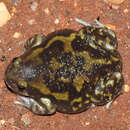Description
provided by AmphibiaWeb articles
This frog has a rotundly shaped stout body that is kept puffed round like a ball.Snout scarcely longer than diameter of the orbit; no canthus, snout round; fingers moderate, first a little shorter than second; toes short webbed at the base; a pair of strong shovel-shaped metatarsal tubercles, inner larger; tibiotarsal articulation does not reach to the shoulder joint; dorsum smoothly tubercular, supratympanic fold present, throat and chest smooth, belly and anal region granular. a medial buccal ridge ending in 2 papillae lying between the internal naris, a similar papilla below each internal nare.Color: Body dorsum with more or less symmetrical dark brown pattern on a pinkish brown background. Ventrum whitish immaculate.very rare
- Abdulali, H. (1962). ''An account of a trip to the Barapede Cave, Talewandi, Belgaum District, Mysore State, with some notes on reptiles and amphibians.'' Journal of Bombay Natural History Society, 59, 228-237.
- Bole-Gowda, B.N. (1948). The Spermatogenesis of Uperodon systoma. Unpublished dissertation, Mysore University, Mysore.
- Gvozdik, L. and Radek, H. (1997). ''A small collection of amphibians from Baluchistan and Punjab, Pakistan in the Silesian Museum.'' Časopis Slezského Muzea Opava, Série A, 46, 203-208.
- Kirtisinghe, P. (1957). The Amphibia of Ceylon. Self-published, Colombo, Sri Lanka.
- Mukerji, D.D. (1931). ''Some observations on the burrowing toad Cacopus globulosum Günther.'' Journal and Proceedings of the Asiatic Society of Bengal, 27, 97-100.
- Rao, C.R.N. (1918). ''Notes on the tadpoles of Indian Engystomatidae.'' Records of the Indian Museum, 15, 41-45.
Distribution and Habitat
provided by AmphibiaWeb articles
Uperodon systoma is a very rare frog in Pakistan. Recently a specimen was collected from the foot of Shakarparian Hills, Islamabad, from the side of a torrent during a wet May night (Gvozdik and Radek 1997; Baig and Gvozdik 1998). Abdulali (1962) reported large numbers of this frog in Khanapur, Mysore, southern India, in the month of May. This species is widely distributed in southern and eastern India, extending into northern Sri Lanka (Kirtisinghe 1957).
Life History, Abundance, Activity, and Special Behaviors
provided by AmphibiaWeb articles
A completely fossorial species, it surfaces only during summer monsoons. The frog moves by small hops or slowly walks on the ground. It is a weak swimmer that usually floats in water; however, it is known to be an excellent burrower, quickly burrowing into the loose moist soil with the help of its well-developed and powerful metatarsal tubercles. During burrowing the loosened soil is thrown sideways by its powerful hind legs and the animal sinks into the cavity so formed, with the eyes the last to disappear underground. Moist soil is essential for this frog. During dry months the frog retreats into the moist environs of termite nests, termites baing its main food item. Mukerji (1931) collected a specimen of Uperodon globulosum from a depth of 1-1.5 m. It had lived for 13 months without food. The body of the frog is globular due to the enormously developed inflated lungs. The breeding season extends from May to July, during monsoon rains (Ferguson 1904). The males call from the banks of torrents or paddy fields. The call is like a bleating goat, and during calling the subgular vocal sac is distended so enormously it looks like a float. The eggs are laid in masses which float on the surface of the water (Ferguson 1904; Annandale and Rao 1918). Karyotype number recorded for this species is 26 (Bole Gowda, 1948). Tadpole: The head and body of the tadpole is oval, with long pointed tail, broader ventral fin. The tail is about twice the length of head and body. The mouth is terminal and lacks a typical denticulate oral disc. Naris is nearer to the eye than the tip of the snout. The spiracle is a median ventral tube, opening in front of anal aperture. Total length of the tadpole 27-27.5 mm, tail 16-17 mm.

